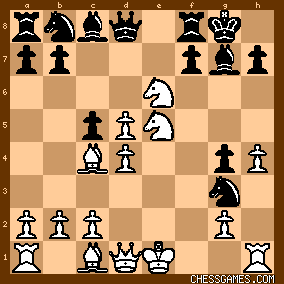Pawn and Two: Regarding the move 12.Ne6: 
click for larger view Schlechter in his game with Steinitz, Steinitz vs Schlechter, 1897 stated the move was, <a neat innovation>. Schlechter did not provide any analysis for 12.Ne6. In "Akiba Rubinstein: The Later Years", Donaldson and Milev gave an exclamation mark to 12.Ne6. However, they provided no analysis for this move. Fritz indicates 12.Ne6 is winning for Black after: (-3.92) (21 ply) 12...fxe6 13.Bg5, (-4.38) (21 ply) 13...Qd6 14.Qxg4 exd5 15.Qxg3 dxc4 16.Rf1 Bf5 17.Bf4 Nc6 18.Nxc6 Qxc6. Or after: 12.Ne6 fxe6 13.dxe6 Bxe6 14.Bxe6+ Kh8, (-4.98) (22 ply) 15.Be3 Nxh1 16.Qxg4 Bxe5 17.dxe5 Nc6 18.Rd1 Qa5+ 19.c3 Qb5, and Black is winning. Even after the game continuation 12.Ne6 Bxe6, Fritz indicates Black had the advantage: (-.96) (21 ply) 12...Bxe6 13.dxe6 Nxh1! (not 13...Qxd4?, as played in the game), (-1.00) (21 ply) 14.Qxg4 Nc6 15.exf7+ Kh8 16.Nxc6 Qf6 17.Be3 bxc6. By his 12th move, White was at a considerable disadvantage. Fritz indicates his best try was: (-1.46) (21 ply) 12.Rh2 cxd4 13.Ned3 Qc7 14.Bb3 a5 15.a4 Na6 16.Kf2 Ne4+ 17.Kg1. Black could continue with advantage by 17...Nac5. Further analysis would be needed to determine if this position is winning for Black. Earlier, White would have had a near equal game with: 9.0-0! Qxh4 10.Qe1 Qxe1 11.Rxe1 0-0, (-.20) (21 ply) 12.Nc3 Nd7 13.Nb5 c6 14.dxc6 Nxe5 15.cxb7 Rb8 16.dxe5 Rxb7 17.b3. After 9.Nc3?, Black could have obtained good winning chances with 9...Nd7!, (-1.50) (21 ply) 11.Nxf7 Rxf7 12.d6 f3 13.gxf3 Ndf6 14.Qd3 Qxd6, or (-1.50) (21 ply) 11.Nxd7 Bxd7 12.Bxf4 Nxf4 13.Nxf4 Re8+ 14.Kf1 Re4. Donaldson & Minev also recommended 9...Nd7!, stating <"Recent theory recommends 9...Nd7">. | 




